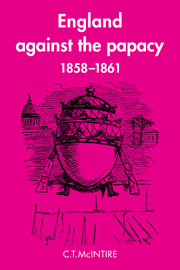 England Against the Papacy 1858–1861
England Against the Papacy 1858–1861 Book contents
- Frontmatter
- Contents
- Acknowledgments
- A note on the footnotes and abbreviations
- Maps
- Introduction
- 1 ‘English Liberties’ and ‘The Government of Priests’
- 2 Odo Russell and the network of English–papal relations
- 3 Tories, the pope, and peace
- 4 Tories, the pope, and war
- 5 Liberals and the revolution in the Romagna
- 6 Liberals, the congress and the Romagna
- 7 Liberals and the annexation of the Romagna
- 8 Liberals and the annexation of the Marches and Umbria
- Conclusion
- Select Bibliography
- Index
7 - Liberals and the annexation of the Romagna
Published online by Cambridge University Press: 07 October 2011
- Frontmatter
- Contents
- Acknowledgments
- A note on the footnotes and abbreviations
- Maps
- Introduction
- 1 ‘English Liberties’ and ‘The Government of Priests’
- 2 Odo Russell and the network of English–papal relations
- 3 Tories, the pope, and peace
- 4 Tories, the pope, and war
- 5 Liberals and the revolution in the Romagna
- 6 Liberals, the congress and the Romagna
- 7 Liberals and the annexation of the Romagna
- 8 Liberals and the annexation of the Marches and Umbria
- Conclusion
- Select Bibliography
- Index
Summary
England's push for annexation
Lord John Russell acted in mid-January to end the uncertainty created by Le pape et le congrès. In policy statements addressed to Loftus and Cowley he explained that he believed a European congress no longer offered any hope of resolving the question of the Romagna and the duchies:
It appears from the present aspect of affairs that either the Congress will not meet at all, or that, if it should meet, it must be divided by irreconcilable differences of opinion.
Between the doctrine, that it will be the duty of a Congress to restore the authority of the Pope in Romagna, and the doctrine that no force ought to be used to impose a Government or Constitution on the people of Central Italy, there can be no agreement.
The English government, he said, aimed to provide another means of reaching a settlement of the crisis in central Italy. With that he began the English push for annexation.
Both the English and papal governments, as principals of the opposing sides, found the waiting period after the publication of the pamphlet disturbing. For one thing Russell thought the pope could start a war. When the English cabinet, on 3 January, declined to endorse a triple alliance against Austria, Russell believed he had no adequate defence against the resumption of fighting in Italy. The day following this indecisive cabinet meeting Russell wrote to Loftus: ‘I think the recruiting [for the papal army] at Vienna may bring affairs to a crisis.’
- Type
- Chapter
- Information
- England Against the Papacy 1858–1861Tories, Liberals and the Overthrow of Papal Temporal Power during the Italian Risorgimento, pp. 163 - 188Publisher: Cambridge University PressPrint publication year: 1983
